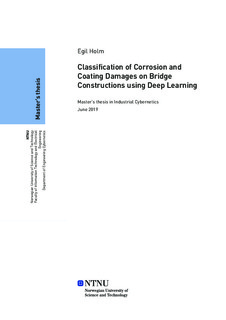| dc.contributor.advisor | Stahl, Annette | |
| dc.contributor.author | Holm, Egil | |
| dc.date.accessioned | 2019-10-31T15:11:11Z | |
| dc.date.issued | 2019 | |
| dc.identifier | no.ntnu:inspera:35771502:16590630 | |
| dc.identifier.uri | http://hdl.handle.net/11250/2625731 | |
| dc.description.abstract | Denne masteroppgaven presenterer en sammenligning av ytelse for forskjellige nevrale nettverk på bildeklassifisering av korrosjon og beleggskader på brukonstruksjoner. Totalt 9300 bilder, delt inn i fire klasser; malingsavflaking, rød korrosjon på armering, rød korrosjon på stålkonstruksjon og ikke korrosjon, ble samlet gjennom manuell kategorisering og augmentasjon. Fire forskjellige nevrale nettverk, kalt AlexNet, GoogLeNet, ResNet- 50 og VGG-16 ble trent og testet på de kategoriserte bildene for å evaluere potensialet i bruk av nevrale nettverk for automatisk analyse av skader på brukonstruksjoner. Hvert nettverk ble trent og testet ved å bruke både tre og fire klasser for å sammenligne ytelse avhengig av antall bilder som ble brukt til trening og testing. Evalueringer og sammenligninger ble gjort gjennom ytelsesmålinger kalt recall, presisjon, nøyaktighet og F1. De nevrale nettverkene ble også evaluert på evnen til å oppdage skader, noe som innebar at antall falske positiver for ikke korrosjon ble undersøkt. I denne oppgaven ga VGG-16 med fire klasser de beste resultatene med gjennomsnittlige verdier for recall, presisjon, nøyaktighet og F1 på henholdsvis 95.45%, 95.61%, 97.74% og 95.53%. Nettverket med beste resultat på evnen til å oppdage skader ble oppnådd med AlexNet, trent og testet med fire klasser, hvor deteksjonsnøyaktigheten ble 99.14%. Fra resultatene som er oppnådd i denne oppgaven, konkluderes det med at nevrale nettverk har et stort potensial i automatisk analyse av korrosjon og overflateskader på brukonstruksjoner. I kombinasjon med en drone og et 3D-program for lokalisering av bilder tatt under inspeksjon, vil et dataanalysesystem som bruker nevrale nettverk gi en fullstendig oversikt over tilstanden til en brukonstruksjon. Dermed kan nødvendige tiltak knyttet til reparasjoner og vedlikehold utføres effektivt. Når det gjelder videre arbeid, anbefales det å samle inn flere relevante bilder av skader til bruk i nettverksopplæring for å forbedre ytelsen for nevrale nettverk. I tillegg betraktes utnyttelse av såkalte “regions of interest” eller segmentering, for å bedre kunne merke relevante områder av et bilde, som en egnet tilnærming i videre arbeid. | |
| dc.description.abstract | This master’s thesis presents a comparison of performance for different convolutional neural networks on image classification of corrosion and coating damages on bridge constructions. A total of 9300 images, divided into four classes; paint flaking, red corrosion on rebar, red corrosion on steel construction and not corrosion, were collected through manual categorization and image augmentation. Four different convolutional neural networks called AlexNet, GoogLeNet, ResNet-50 and VGG-16 were trained and tested on the collected images in order to evaluate the potential in using neural networks for automatic analysis of damages on bridge constructions. Each neural network was trained and tested using both three and four classes for comparison of performance scores depending on the number of images used in training and testing. Evaluations and comparisons were done through the performance metrics recall, precision, accuracy and F1 score. The neural networks were also evaluated on the ability of detecting damages, meaning that the number of false positives for not corrosion were studied. In this thesis, VGG-16 with four classes gave the overall best performance results with average values for recall, precision, accuracy and F1 score being 95.45%, 95.61%, 97.74% and 95.53%, respectively. The highest score on damage detection was achieved with AlexNet, which was trained and tested with four classes, where a detection accuracy of 99.14% was achieved. From the results obtained in this thesis, it is concluded that convolutional neural networks have a great potential in automatic analysis of corrosion and coating damages on bridge constructions. In combination with a drone and a 3D program for localization of images taken during inspections, a data analysis system using convolutional neural networks will give a complete overview of bridge construction condition. Thus, necessary measures related to repairs and maintenance can be performed efficiently. Regarding further work, collection of more relevant images of damages for network training is recommended in order to improve classification performance for convolutional neural networks. In addition, utiliziation of regions of interest or segmentation for better labeling of relevant areas of an image is considered to be a suitable approach. | |
| dc.language | eng | |
| dc.publisher | NTNU | |
| dc.title | Classification of Corrosion and Coating Damages on Bridge Constructions using Deep Learning | |
| dc.type | Master thesis | |
